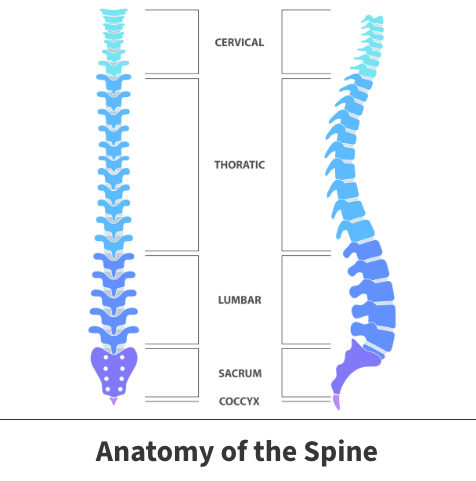Bone cement injection
The backbone and spinal column are your body’s structural foundations. They help you stand up, move your limbs freely, and perform other vital functions.
The vertebra are a crucial part of your spine. The collection of these small bones makes up your backbone. When they are damaged or diseased, you could experience significant discomfort and potentially life-altering symptoms.
An injured vertebra can be treated through a surgical procedure called bone cement injection, also known as vertebroplasty.
Anatomy

The vertebrae are the small bones in your backbone.
People are born with 33 vertebrae, which shrinks to 24 in adulthood. This decrease happens because many vertebral bones in your lower back fuse together as your body grows.
The vertebrae are divided into several sections depending on their location. These vertebral regions include the lumbar, sacrum, coccyx, cervical, and thoracic.
About
When these bones sustain an injury, disease, or gradually deteriorate, broken or chipped bone fragments can press against important nearby parts like nerves. In medical terminology, this is called compression.
Causes of vertebral-induced spinal compression
One of the more common causes is a medical condition named osteoporosis. If you have this problem, your bones lose mass and density and grow brittle and weak. Over time, these factors could increase your risk of injuries like fractures.
Compression-causing vertebral breaks can result from cancerous and non-cancerous tumors, infections, or various immune system disorders. These fractures are called pathological breaks.
This issue may result from traumatic incidents. For example, most vertebral fractures in younger people are caused by trauma such as car accidents, falls from significant heights, excessive or forceful physical contact, or contact experienced during physical athletic competitions.
Symptoms
The most common spinal fracture symptom is back pain. This discomfort often appears suddenly and worsens when you stand, walk, or engage in any significant movements. You might also experience the following:
- Lessening pain when lying down
- Discomfort spreading to your arms, legs, or neck
- Numbness and tingling in your extremities
- Increasingly limited mobility
More severe or advanced cases may lead to height loss, visual abnormalities, posture issues, and possibly even paralysis.
Risk factors
Though compression fractures can impact anyone, your risk is heightened if you are or have been:
- Female
- Post-menopausal
- Older than 65
- Overweight or obese
- Medications that can weaken bones like steroids or anti-depressant drugs
- Affected by a previous compression fracture
You are at higher risk of vertebral injury if you have unhealthy lifestyle habits like:
- Drinking alcohol excessively
- Cigarette smoking
- Not eating a diet containing bone-strengthening nutrients like calcium
- Remaining physically inactive

Diagnosis
Your physician may diagnose a compression fracture based on a physical and visual examination.
Pinpointing the condition’s severity or your potential candidacy for bone cement injection will likely need an X-ray, MRI (magnetic resonance imaging), CT (computerized tomography) scan, or bone density measuring machine.
Treatment
During the procedure, surgeons inject specialized cement into the damaged vertebra to fix and strengthen the broken spinal bones.
Are you a good candidate?
If less aggressive treatment methods do not ease pain or symptoms, your doctor might recommend this procedure. These nonsurgical treatments may include:
- Rest
- Movement-restricting devices like back braces
- Physical therapy
Bone cement injection is recommended if you are dealing with significant mobility problems or if the fracture has resulted in severe or life-threatening complications.
Preparation
You will not be permitted to eat or drink anything in the least six hours before your scheduled surgery. If your operation is in the morning, you may be asked to fast the night before.
You should inform your surgeon of any medications you take before the procedure. Certain drugs could increase your risk of potentially serious complications like infection or bleeding.
The process
The procedure is usually performed with you under sedation with full general anesthesia. Then, using an X-ray as a guide, surgeons insert a needle into your spine until reaching the damaged backbone. Once the vertebra is identified, the needle injects the cement into the cracked area until the opening is completely sealed.
Recovery
If the procedure does not have complications, you may be able to return home later that day. It is crucial to check your vital signs to ensure you are stable before you leave. You will also be required to attend follow-up examinations where your doctor will track the healing progression.
Intended benefits
The procedure is usually well-tolerated, and most patients only experience minor and short-lived side effects. Most bone cement injection patients experience immediate pain relief and enjoy better mobility.
Videos
Related specialties
- Anterior Cervical Corpectomy & Discectomy
- Artificial Disc Replacement (ADR)
- Degenerative Disc Disease
- Diffuse Idiopathic Skeletal Hyperostosis (DISH)
- Discectomy
- Discitis Treatment & Information
- Epidural Injections for Spinal Pain
- Foraminotomy
- Interlaminar Implants
- Interlaminar Lumbar Instrumental Fusion: ILIF
- Kyphoplasty (Balloon Vertebroplasty)
- Kyphosis
- Laminectomy: Decompression Surgery
- Lumbar Epidural Steroid Injection
- Lumbar Interbody Fusion (IBF)
- Minimally Invasive Spine Surgery
- Outpatient Spine Surgery
- Pinched Nerve
- Piriformis Syndrome
- Sacroiliac Joint Pain
- Sciatica
- Scoliosis
- Spinal Fusion
- Spondylolisthesis & Spondylolysis
- Vertebroplasty
- Whiplash & Whiplash Associated Disorder (WAD)
